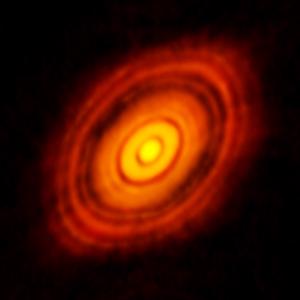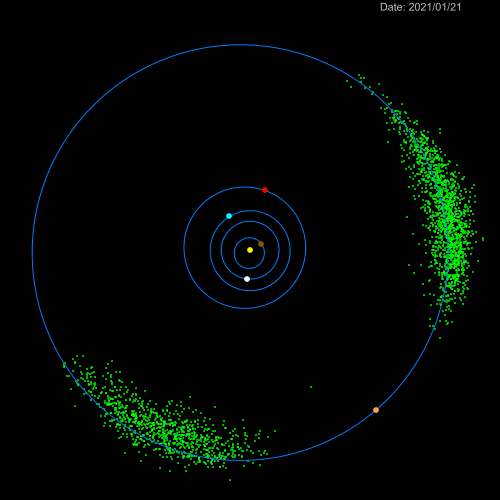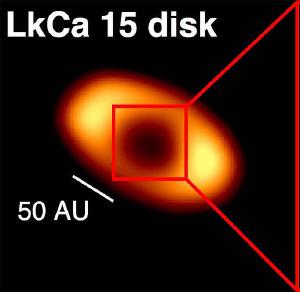Blog
Trojan Horse
17 September 2022
 M.Weiss/Center for Astrophysics | Harvard & Smithsonian
M.Weiss/Center for Astrophysics | Harvard & SmithsonianAlthough we have found thousands of exoplanets in recent years, we really only have three methods of finding them. The first is to observe a star dimming slightly as a planet passes in front of it (transit method). The second is to measure the wobble of a star as an orbiting planet gives it a gravitational tug (Doppler method). The third is to observe the exoplanet directly. Now a new study in the Astrophysical Journal Letters has a fourth method.1
Each of the methods we currently use has its drawbacks. The transit method only works when an exoplanet’s orbit is lined up with our view of the star, the Doppler method tends to favor larger planets orbiting close to a small star, and the direct observation is best for large planets orbiting far from their star. But all of these methods only work for planets orbiting middle-aged stars. That is stars that have long since cleared the dust and debris around them. So while we have learned a great deal about the types of planetary systems that are out there, we’ve learned less about how young star systems form.
 ALMA (ESO/NAOJ/NRAO)
ALMA (ESO/NAOJ/NRAO)Thanks to radio observatories such as ALMA, we have gotten a good view of early debris disks around very young stars. These disks emit a faint radio glow that ALMA is particularly effective at seeing. One of the things we’ve noticed in many of these disks is that they have gaps or bands within them. We think they are caused by young planets that have cleared a path in the debris disk as they grow and evolve. The problem is that we can’t be certain that’s what’s happening. There are other possible explanations, such as turbulence or gravitational resonances within the disk that causes gaps to form. The problem is that while we can study the structure of the gaps, telescopes like ALMA can’t resolve an actual planet orbiting within a gap. Even a planet as large as Jupiter is too small to clearly detect directly.
 Astronomical Institute of CAS/Petr Scheirich
Astronomical Institute of CAS/Petr ScheirichSo this new study took a different approach. Instead of trying to detect an exoplanet in the disk directly, why not look for signs within the debris disk that the planet is there? And they’ve found a pattern that works. You might even call it their trojan horse.
Jupiter is by far the most massive planet in our solar system, and over time it has influenced the orbits of smaller bodies such as asteroids. One of the clear influences is on the asteroid belt, where it has induced resonant gaps known as Kirkwood gaps. The other is in the collection of asteroids it has gathered to its orbit, known as the Trojans.
Trojan asteroids are small bodies that have happened to get trapped in Jupiter’s Lagrange points. These are regions in Jupiter’s orbit about sixty degrees ahead and behind Jupiter itself. Through the gravitational dance of Jupiter and Sun, the Lagrange points are rather deep gravitational wells, so anything that finds itself there tends to stay there. So as Jupiter parades around the Sun, it has a cluster of Trojans marching along ahead and behind it.
 Adam Kraus and Michael Ireland
Adam Kraus and Michael IrelandIn this new study, the team focused on a young star known as LkCA 15 and looked for similar gravitational dynamics. By analyzing high-resolution images of the star and its debris disk, they found two very faint clusters of dust. The clumps were in the same orbit within the debris disk, and they were separated by an angle of 120 degrees. In other words, the clumps have all the signs of being within the Lagrange points of a young planet. Based on the data, the team estimates the planet is roughly the size of Neptune or Saturn. Given that the planet is likely only a couple of million years old, it seems to have formed pretty quickly.
All of this paints an interesting picture of planetary evolution. Large planets seem to form early within a star system, and they almost immediately start influencing its gravitational dance. The next question is whether astronomers can find similar planets in other young star systems using the same method.
Long, Feng, et al. “ALMA Detection of Dust Trapping around Lagrangian Points in the LkCa 15 Disk.” The Astrophysical Journal Letters 937.1 (2022): L1. ↩︎